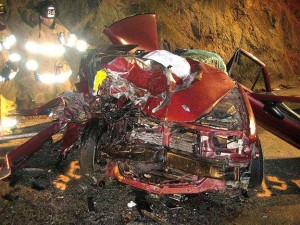When the National Academy of Sciences earlier this year ruled out the likelihood of unknown electronic gremlins causing so-called unintended acceleration problems with Toyota vehicles researchers instead suggested that driver error was largely to blame.
A new study echoes the likelihood that drivers may hit the throttle when intending to reach for the brake – while also say the majority of such accidents involve older women and occur primarily in parking lots. But the report by the National Highway Traffic Safety Administration also points the finger at drivers under 20.
Particularly striking is the finding that nearly two-thirds of the drivers involved in accidents involving the misuse of the gas pedal are female. In all motor vehicles crashes, nearly two in three drivers are male, NHTSA reports.
“The most consistent finding across data sources was the striking overrepresentation of females in pedal misapplication crashes, relative to their involvement in all types of crashes,” the study’s authors declared in an executive summary. “Females were the drivers in nearly two-thirds of the pedal misapplication crashes” included in the study.
The federal agency is now proposing new regulations that would require automakers to install brake-throttle override systems. These would automatically cut power to the engine in the event a motorist inadvertently depressed both the brake and throttle at the same time. A number of manufacturers have begun installing such systems voluntarily, including Toyota which recalled millions of vehicles in 2009 and 2010 due to unintended acceleration problems.
“We learned as part of the comprehensive NASA and NHTSA studies of high-speed unintended acceleration that brake override systems could help drivers avoid crashes,” said NHTSA Administrator David Strickland.
(For more on the NHTSA brake-throttle override proposal, Click Here.)
Not all unintended acceleration issues are the result of driver error. The first Toyota recall was related to what was dubbed “carpet entrapment,” where loose floor mats could inadvertently jam the throttle open. The second was the result of a potentially sticky throttle linkage. But a series of subsequent studies ruled out electronic malfunctions and evidence in a number of reported unintended acceleration incidents supported the idea of driver error. In one New York crash authorities found the driver had pressed so hard on the accelerator, thinking it was the brake, its metal linkage was bent.
Why do women in particular have such a high incident of brake misapplication incidents?
The authors noted, “Possible explanations might include greater exposure by women where these crashes occur most often (parking lots); a poorer “fit” in their cars due to shorter stature, which may increase the likelihood of a pedal application error; or a disproportionately high rate of one or more functional deficits that contribute to pedal errors, such as neuropathy.”
The new NHTSA study reveals that the misapplication of pedals leading to a crash occurs most frequently among drivers over 76 years of age, with those under 20 the second most likely age group to experience the problem. And researchers suggest that may be the result of problems in the area of the brain that handle executive functioning – which are responsible for tasks like choosing which pedal to depress.
Other studies have found that the areas of the brain responsible for such decisions don’t fully form until around age 25 – while those regions also show declining functionality in the elderly.
The new NHTSA study was based on several sources including analysis of 2,400 gas pedal incidents in North Carolina – as well as an analysis of 900 news reports of unintended acceleration crashes. In the North Carolina state database 57% of such crashes occurred in driveways, parking structures or parking lots. That jumped to 77% in the news reports.
The study, conducted by the University of North Carolina’s Highway Safety Research Center, and TransAnalytics, an independent research firm in Pennsylvania, suggested drivers have more time to correct pedal mistakes made on the open road.

